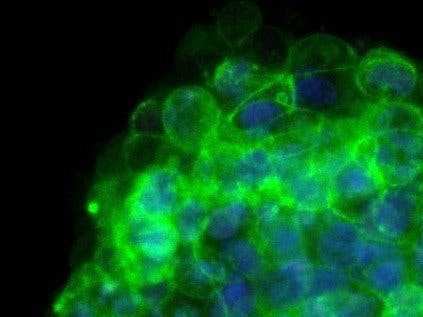To study mammalian development an in vitro “Gastruloid model system” has been established in Martinez Arias Laboratory (Department of Genetics, University of Cambridge). The model allows the use of cultured mouse Embryonic Stem Cells (mESCs) which are able to organise themselves into structures similar to the gastrulating embryo (gastruloids) with polarised gene expression, axial elongation/organisation and expression of specific markers (such as Brachyury, Nodal, and Sox2). Analysis of gene expression in gastruloids let us understand the important aspects of the spatial arrangements and general behaviors which reproduces embryo development during early symmetry breaking and gastrulation.
The beauty of the Gastruloid model is that there is no need for use of animals, the cell aggregates are formed form quickly and require only cultural media; the Gastruloids can be fixed at different stages of progression and the desirable genes can be visualized with immunostaining or in situ hybridization. The method also allows to manipulate with the cells and cell aggregates by adding cytokines, growth factors and small chemical molecules to modulate gene behavior, as well as to trace the genes involved in early germ layer formation using fluorescent reporters.
Although this relatively cheap, easy and simple technique provides a basis for studying the processes of self-organization, axial organization and germ layer specification in vitro, the method has some limitations. According to the protocol currently used in the group (Department of Genetics), mouse gastruloids are generated in the round bottom 96-well culture plates (CellStar, Greiner Bio-One). Usually, gastruloids can be maintained floating in the cell culture medium for four days, and at the end of incubation period, they start to elongate and express the germ layer genes.However, gastruloids soon will attached to the well bottom and collapse, therefore, not permitting to carry investigation beyond the day 4. Alternatively, incubating gastruloids in Ultra-Low Attachment plates (Corning® Costar® Ultra-Low Attachment Multiple Well Plate, Sigma-Aldrich) let them stay as a floating 3-D structure and grow for 5-7 days and even longer. The Corning Ultra-Low Attachment surface is a covalently bound hydro-gel layer that is hydrophobic and neutrally charged. This hydro-gel surface naturally inhibits nonspecific immobilization of proteins and other molecules via these forces, thus inhibiting subsequent cell attachment. This surface is very stable, non-toxic, biologically inert and non-degradable. The disadvantage of the plates is that they cannot be used for high resolution live gastruloids 3-D imaging by a confocal microscope due to the thick bottom of the plastic plates which makes them incomparable with confocal microscopes requirements.
To overcome these problems we offer the technology that combines the efforts of the investigators from Engineering and Genetics Departments, University of Cambridge.
Here, we utilized agarose properties to make a device to grow mouse ES cell aggregates. Agarose is a type of a hydro-gel, it is non-toxic for cells, stable, and can be cast solid. The agarose layer on the surface of the wells also has been shown to prevent the cell attachment (unpublished data). We constructed agarose wells in a small round dishes (35mm Dish, No. 0 Coverslip, 15 mm Glass Diameter, Uncoated, MatTek Corporation) with a thin glass window in the centre permitting to use the device for confocal microscopy (Fig.1, A). To achieve the desired shape and size of the wells we created the mould which can be fitted to the dish (Fig.1, B). The base of the wells should not sit more than 0.1 mm higher than the base of the dish in which the wells are made, as the specimens growing in the wells are imaged through the base of the dish. The mould makes the geometry of the wells by lowering gold coated 'pogo' pins into molten agarose, controlling the depth of the moulding by adjusting the jig in which the pins are situated. The jig height isadjusted by screwing its upper and lower half together, giving the userfine control over the depth of the moulding. Producing the finished mould requires only the use of a 3D printer; once the jig is printed, the pins are inserted as a press fit and assembly is complete. The total cost of the mould depends on the cost of the 3D printer and of the pins, but should not exceed £20.
The results of our project allowing investigate the in vitro Gastruloid model system for a longer period of time (up to 7-8 days) making the model comparable with a mouse embryo at gastrulation stage and beyond. It also let us conducting live imaging of the cell aggregates and potentially fluorescence resonance energy transfer(FRET) technique during garstruloid’s growth and spatial cell specification.



Comments
Please log in or sign up to comment.